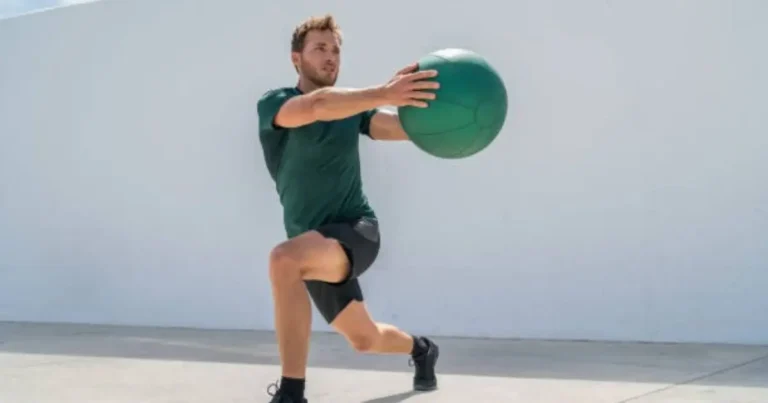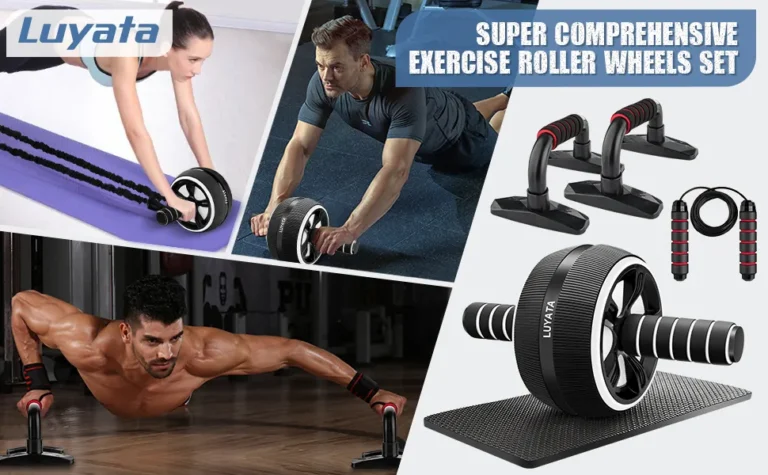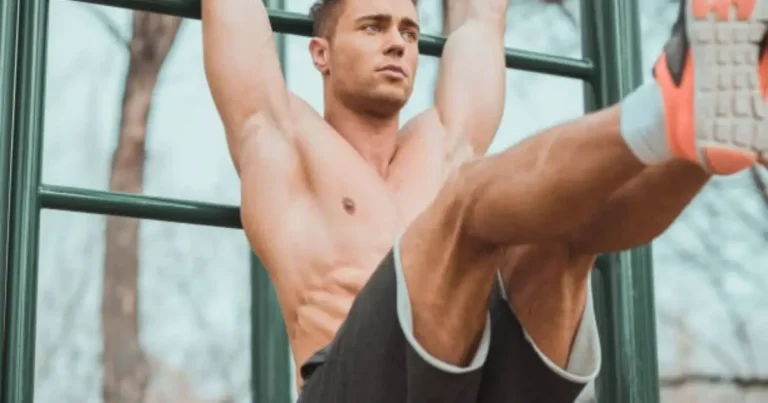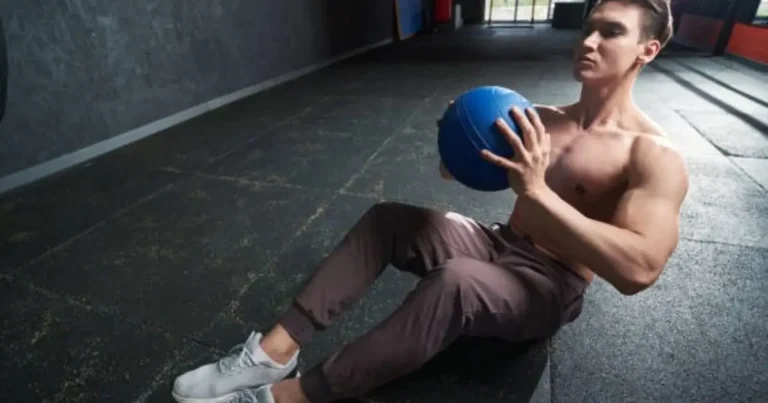The Ultimate Guide to Kettlebell Full Body Workouts: Forge a Stronger, More Functional You!
Unleash Your Full Body Potential with Kettlebell Training: Forge Strength, Power, and Endurance!
If you’re wondering, “What are the best kettlebell exercises for a full body workout?”, you’re in the right place. A kettlebell full body workout delivers strength, conditioning, and functional fitness—all in one efficient session. In this guide, you’ll learn how to build muscle, boost cardiovascular health, burn fat, and enhance mobility with just a single kettlebell.
NLP Keywords: KB training, dynamic kettlebell routines, functional strength workouts
Table of Contents
Why Kettlebells for Full Body Workouts?
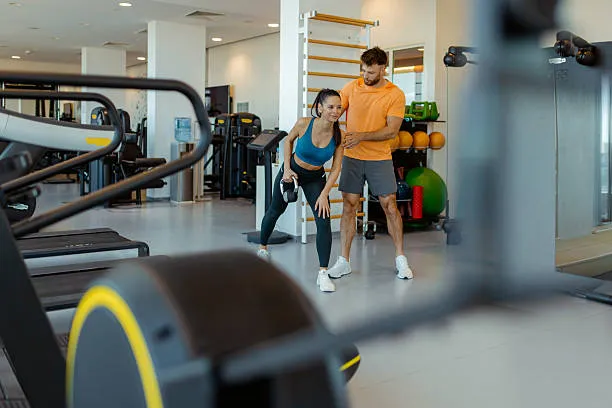
- Full Body Engagement: Each swing, squat, and press recruits multiple muscle groups simultaneously.
- Functional Strength: Kettlebell movements mimic real-world activities, improving daily performance.
- Cardiovascular Conditioning: Continuous, dynamic sequences elevate your heart rate and burn calories.
- Core Stability: Balancing the ball challenges your abs, obliques, and lower back.
- Mobility & Flexibility: Dynamic drills improve hip, shoulder, and thoracic range of motion.
- Time Efficiency: Complete a comprehensive workout in just 30 minutes.
Secondary Keywords: total-body kettlebell routine, quick kettlebell workout
Essential Kettlebell Exercises for a Full-Body Workout
Below are the “Big Six” plus additional key moves. For each, focus on grip, breathing, and control.
| Exercise | Primary Muscles | Variation |
| Kettlebell Swing | Hips, glutes, hamstrings, core | Single-arm swing, double swing |
| Goblet Squat | Quads, glutes, core | Pulse squat, offset goblet squat |
| Kettlebell Clean | Hips, back, shoulders | Alternating clean, rack clean |
| Kettlebell Snatch | Shoulders, core, glutes | Single-arm snatch, power snatch |
| Kettlebell Press | Shoulders, triceps, core | Push press, strict press |
| Turkish Get-Up | Full body (core, shoulders, hips) | Half get-up, suitcase get-up |
| Deadlift | Hamstrings, glutes, lower back | Sumo deadlift, single-leg deadlift |
| Rows | Back, biceps, rear delts | Renegade row, bent-over row |
| Lunges | Quads, glutes, calves | Reverse lunge, walking lunge |
| Windmill | Obliques, shoulders, hips | Half windmill, bottom-up windmill |
| Figure 8 | Core, hips | Figure 8 to hold, figure 8 around the legs |
| Halo | Shoulders, traps, upper back | Reverse halo, lateral halo |
Pro Tip: Breathe out on exertion (e.g., swing up, press overhead), inhale on return.
Designing Your Full-Body Kettlebell Workout
- Exercise Selection: Pick 5–7 exercises to cover the lower body, upper body, and core.
- Sets & Reps:
- Strength: 3–5 sets × 5–8 reps
- Hypertrophy: 3–4 sets × 8–12 reps
- Endurance/Conditioning: 2–3 sets × 15–20 reps or timed intervals
- Rest Periods:
- Strength: 60–90 seconds
- Hypertrophy: 45–60 seconds
- Conditioning: 15–30 seconds
- Frequency: 2–3 workouts/week, with at least one rest day between sessions.
- Warm-Up: 5–7 minutes of joint mobilizations, light swings, and hip hinges.
- Cool-Down: 5 minutes of static stretching focusing on hips, shoulders, and spine.
- Weight Selection: Choose a kettlebell that challenges you by the last rep but allows safe form (e.g., 12–20kg for most intermediate males, 8–12kg for females/intermediate).
Kettlebell Full Body Workout Styles
- Circuits: Rotate through 5–6 exercises with minimal rest. Ideal for fat loss and conditioning.
- Complexes: Perform a sequence (e.g., swing → clean → press → squat) without setting the bell down.
- Flows: String movements fluidly (e.g., swing → snatch → windmill) to build coordination and endurance.
- Interval Training: Alternate work bursts (e.g., 40 seconds on, 20 seconds off) for cardiovascular challenge.
Sample Full-Body Kettlebell Workout Programs
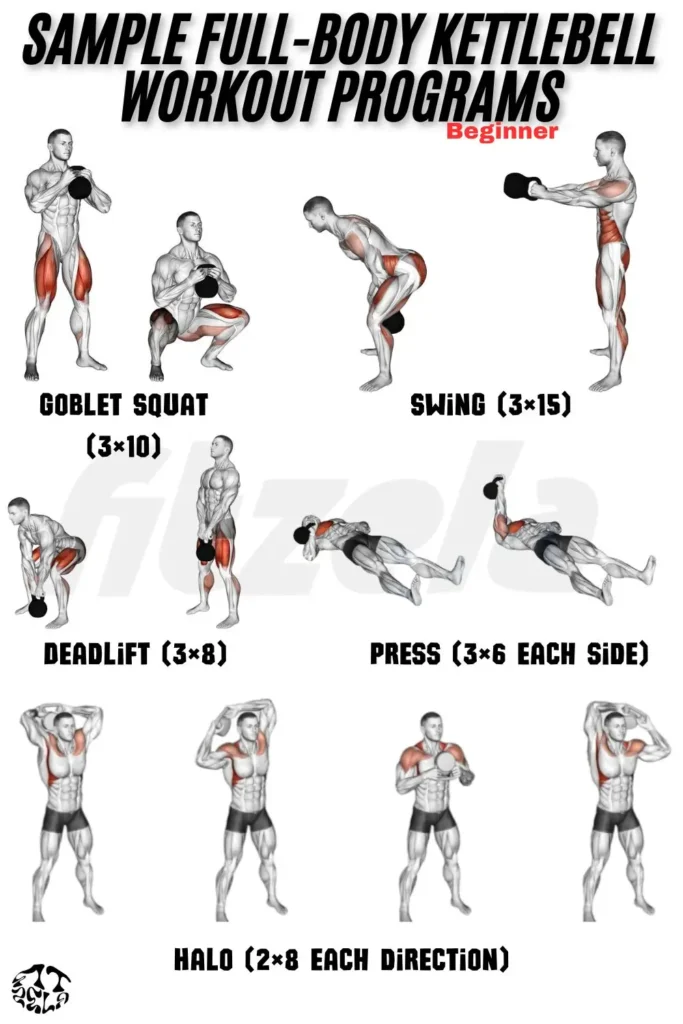
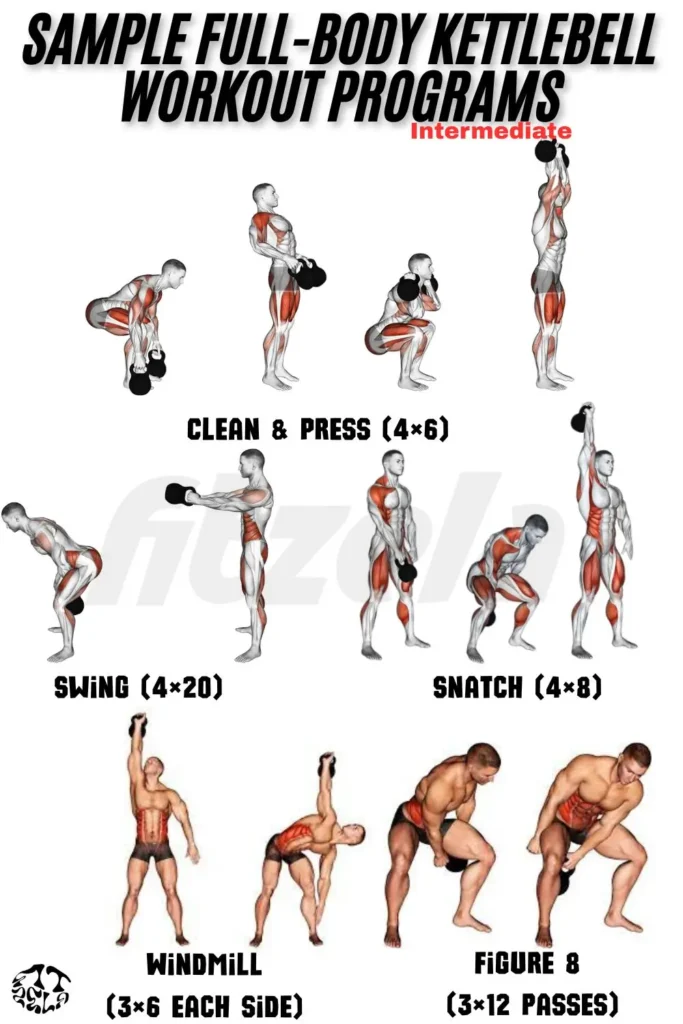
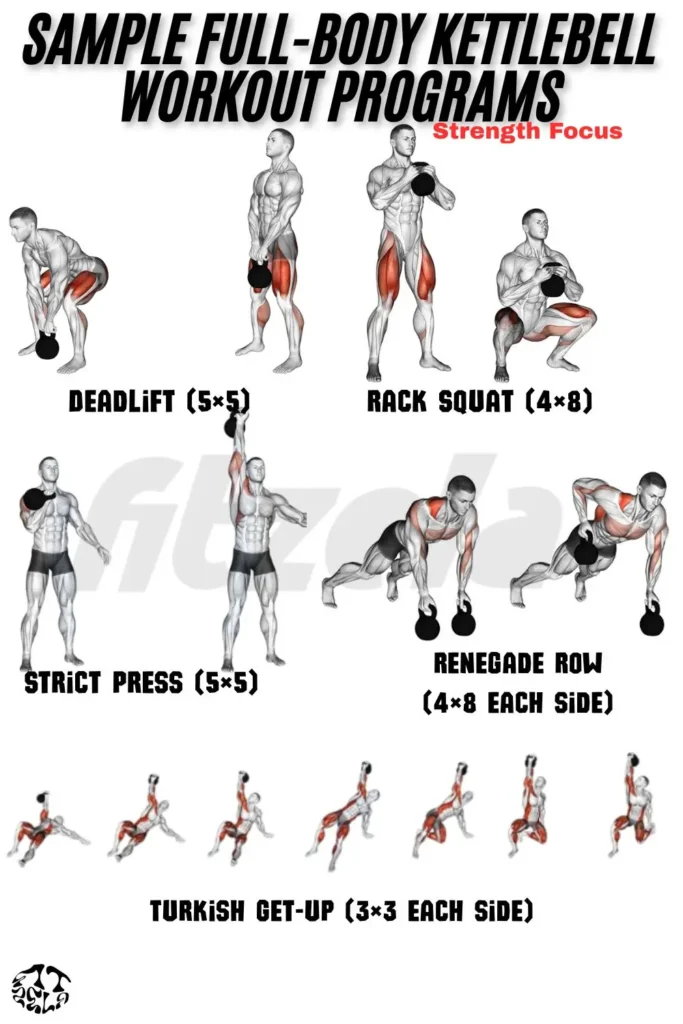
| Program | Exercises (Sets × Reps/Time) | Rest |
| Beginner | Goblet Squat (3×10), Swing (3×15), Deadlift (3×8), Press (3×6 each side), Halo (2×8 each direction) | 60s |
| Intermediate | Swing (4×20), Clean & Press (4×6), Snatch (4×8), Windmill (3×6 each side), Figure 8 (3×12 passes) | 45s |
| Strength Focus | Deadlift (5×5), Rack Squat (4×8), Strict Press (5×5), Renegade Row (4×8 each side), Turkish Get-Up (3×3 each side) | 90s |
| Muscle Growth | Goblet Squat (4×12), Swing (4×15), Clean (4×10), Snatch (4×10), Lunges (3×12 each leg) | 60s |
| Fat Loss Circuit | Circuit × 4: Swing (15), Thruster (12), Russian Twist (20), Reverse Lunge (10 each leg), Halo (8 each direction) | 30s |
| Travel Workout | Single-arm Swing (3×15 each), Halos (2×10), Clean → Press (3×5 each), Goblet Squat (3×10) | 30s |
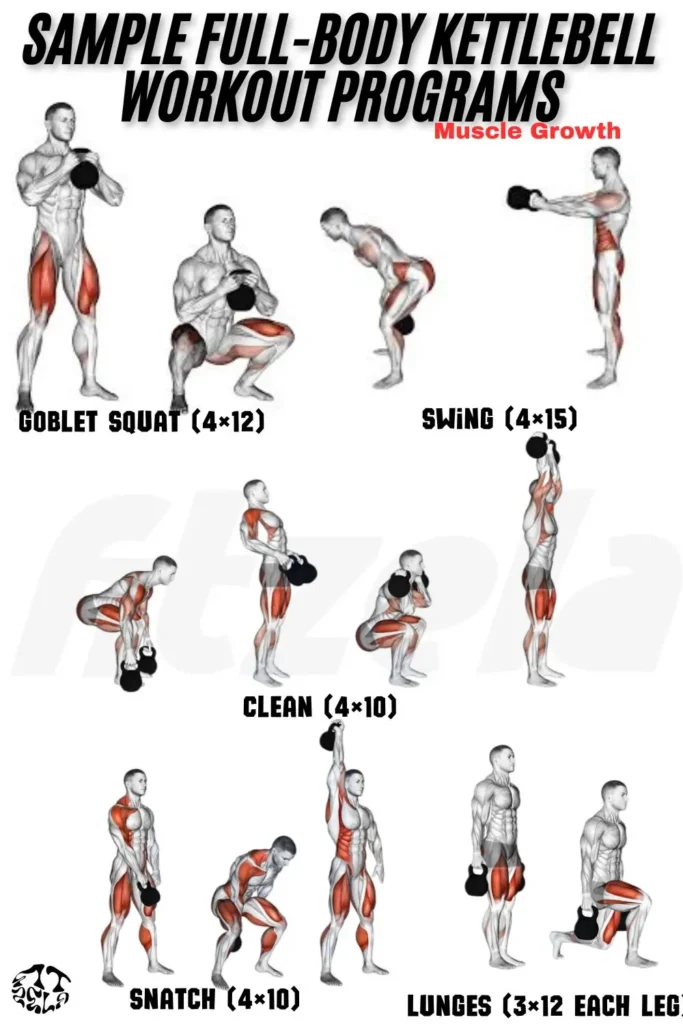
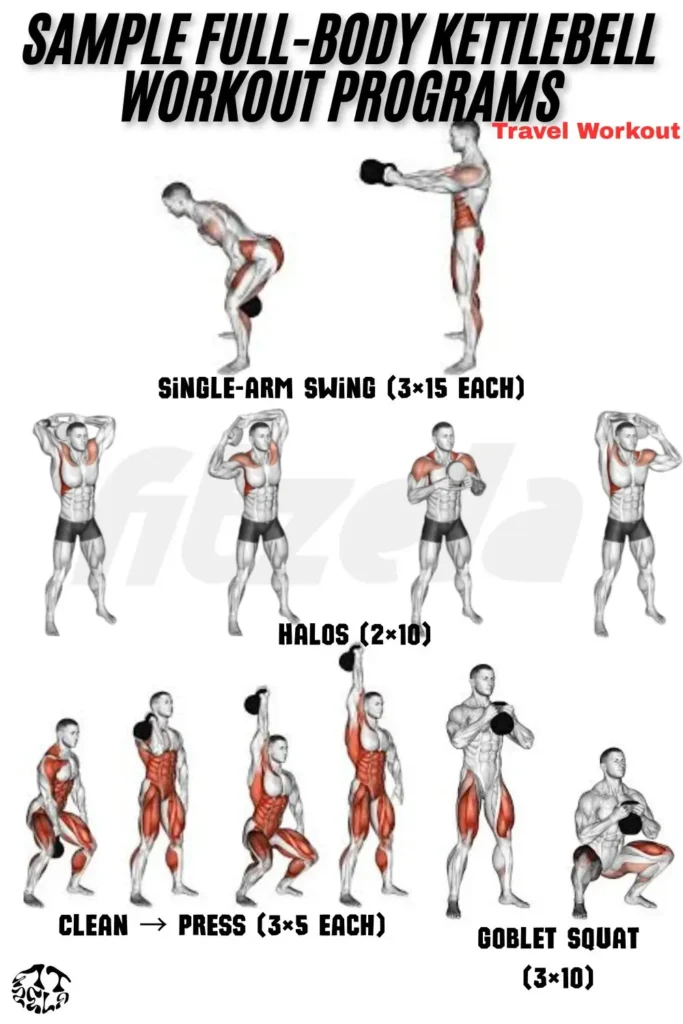
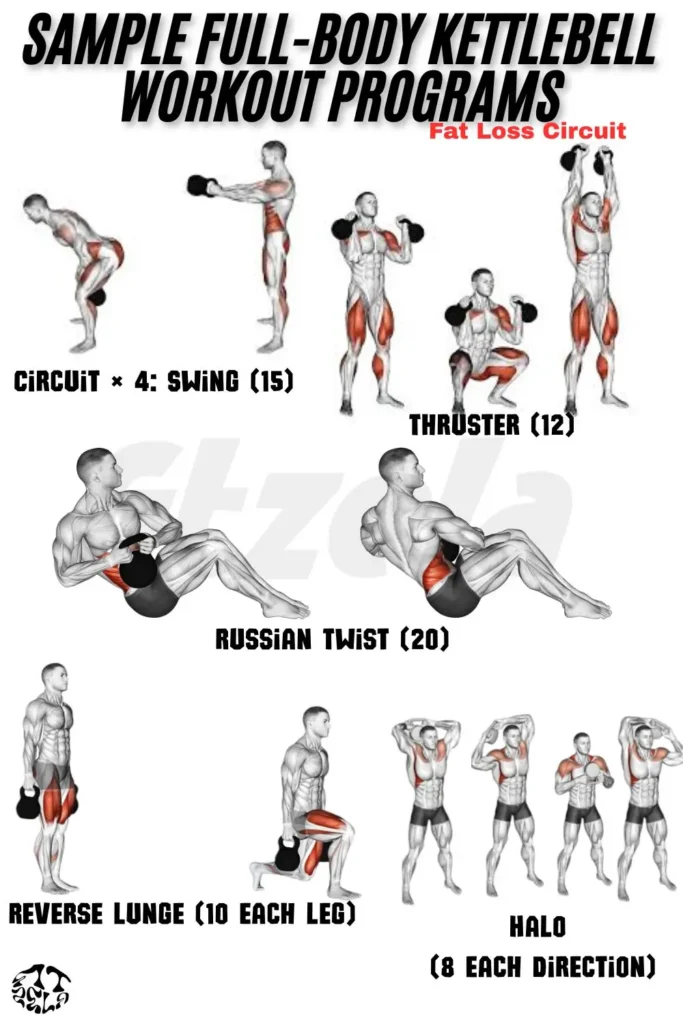
Progressive Overload Techniques
- Increase Weight: Gradually move up in 2kg increments.
- Add Reps: Aim for 1–2 extra reps each session.
- Add Sets: Introduce an additional set every 4 weeks.
- Reduce Rest: Trim 5–10 seconds from rest periods.
- Complexify: Advance from basic swings to single-arm or alternating variations.
- Improve Technique: Slow down tempo, focus on bracing and hip hinge.
Safety Considerations
- Proper Warm-Up: Prioritize hip and shoulder mobility.
- Neutral Spine: Maintain a flat back during swings and deadlifts.
- Grip Strength: Chalk or switch to a thicker handle if slipping.
- Avoid Overstretching: Don’t force snatch lockout beyond shoulder capacity.
- Listen to Your Body: Ease off if you feel joint pain—muscle burn is good, joint ache is not.
- Doctor Clearance: Consult a professional if recovering from an injury.
Troubleshooting Common Problems
- Grip Fatigue: Use lighter weight or alternate grip each set.
- Lower Back Pain: Reassess hip hinge; initiate with hips, not spine.
- Shoulder Discomfort: Check rack position; keep the bell close to your body.
- Fatigue: Scale back volume or increase rest.
Download the training program
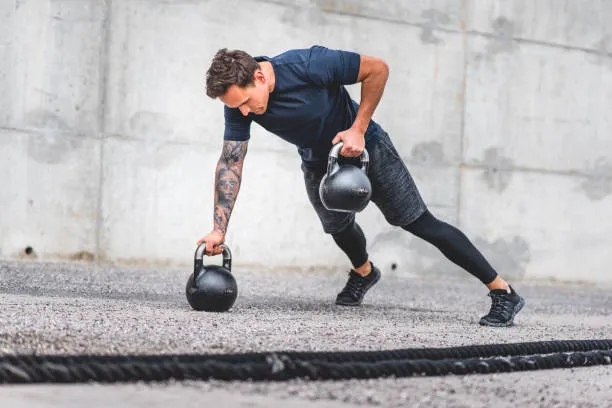
Conclusion
A kettlebell full-body workout is the ultimate combination of strength, cardio, and functional movement. Whether short on time or craving a dynamic challenge, these routines deliver results in just 30 minutes.
Ready to swing into action? Pick a sample program, grab your kettlebell, and share your favorite exercises in the comments below!



